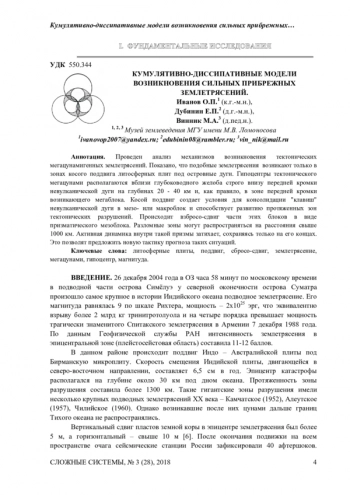Проведен анализ механизмов возникновения тектонических мегацунамигенных землетрясений. Показано, что подобные землетрясения возникают только в зонах косого поддвига литосферных плит под островные дуги. Гипоцентры тектонического мегацунами располагаются вблизи глубоководного желоба строго внизу передней кромки невулканической дуги на глубинах 20 - 40 км и, как правило, в зоне передней кромки возникающего мегаблока. Косой поддвиг создает условия для консолидации “клавиш” невулканической дуги в мезо- или макроблок и способствует развитию протяженных зон тектонических разрушений. Происходит взбросо-сдвиг части этих блоков в виде призматического мезоблока. Разломные зоны могут распространяться на расстояния свыше 1000 км. Активная динамика внутри такой призмы затихает, сохраняясь только на его концах. Это позволят предложить новую тактику прогноза таких ситуаций.
The analysis of the mechanisms of the occurrence of tectonic megacynamigenic
earthquakes was carried out. It is shown that such earthquakes occur only in zones of oblique-slip lithospheric plates beneath island arcs. The hypocenters of the tectonic mega-tsunami are located near the deep-sea trenches strictly at the bottom front edge of the non-volcanic arc at depths of 20-40 km and, as a rule, in the area of the front edge of the emerging megablock. The oblique-slip creates conditions for the consolidation of the “keys” of the non-volcanic arc into a meso- or macroblock and promotes the development of extended zones of tectonic destruction. Happens upthrust-shift of these blocks in the form of prismatic mesoblock. A fault zone may extend over distances more than 1000 km of the Active dynamics within a prism fades and remains only at its ends. This allows us to offer a new tactics of forecasting such situations.




